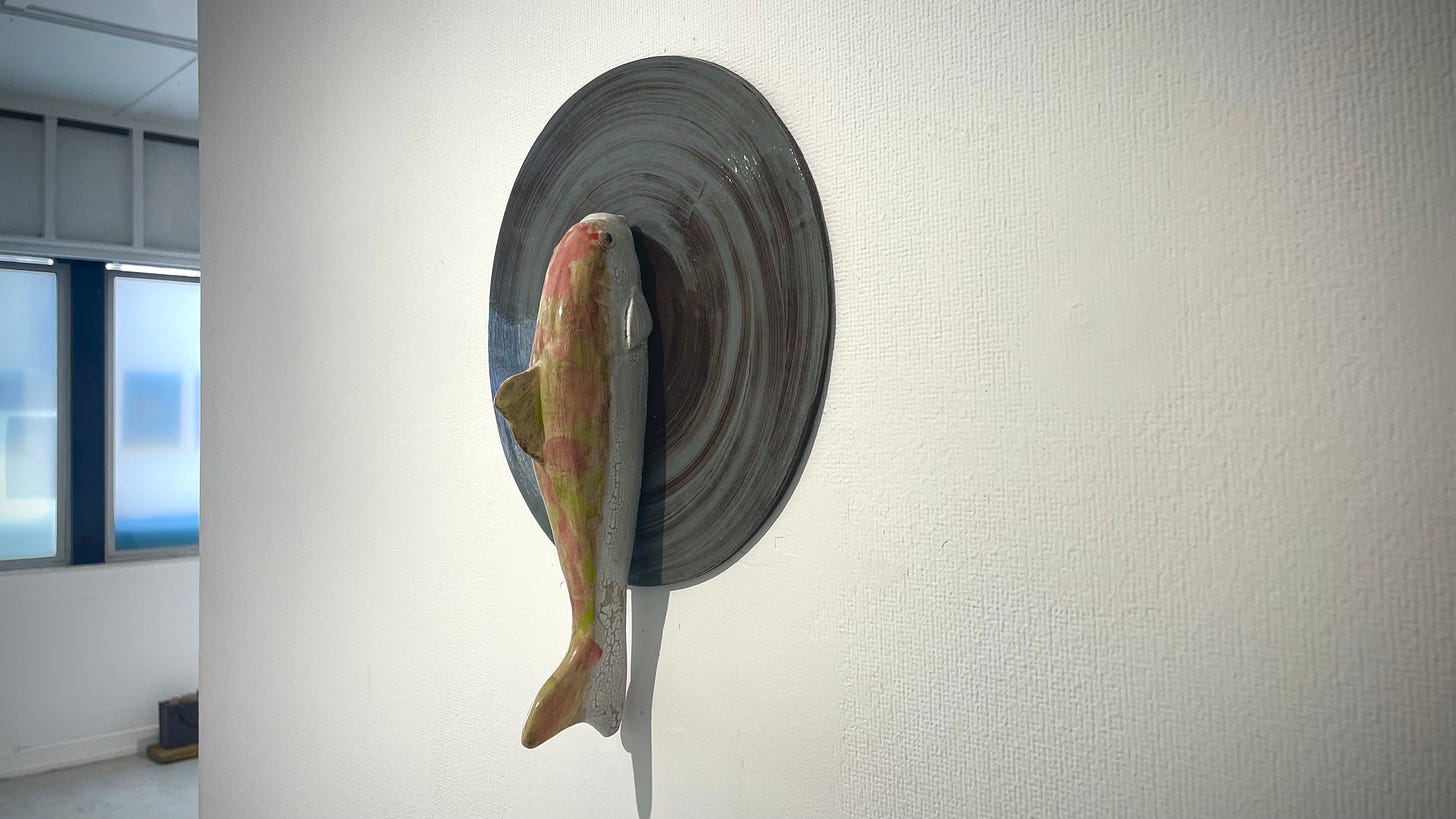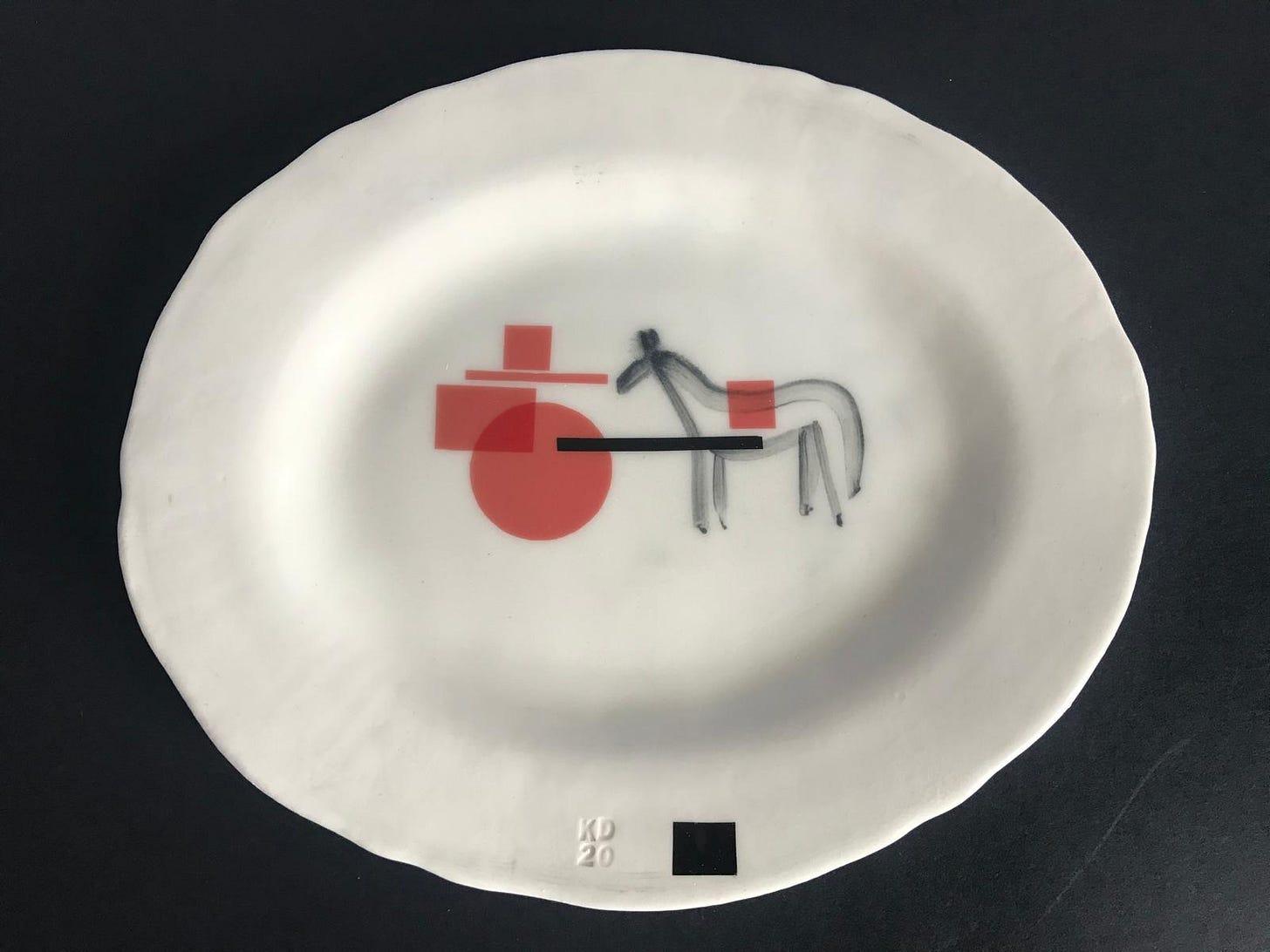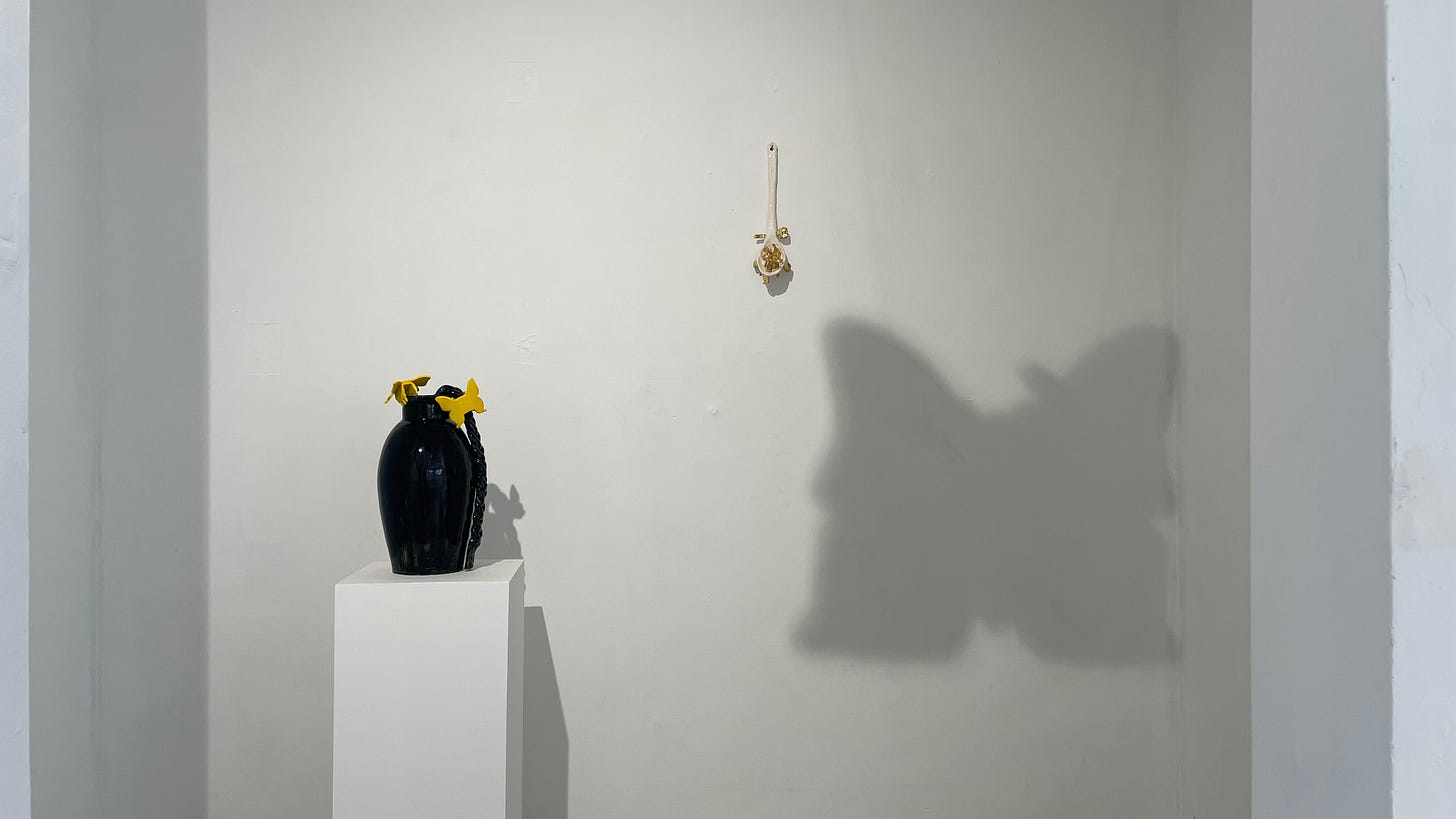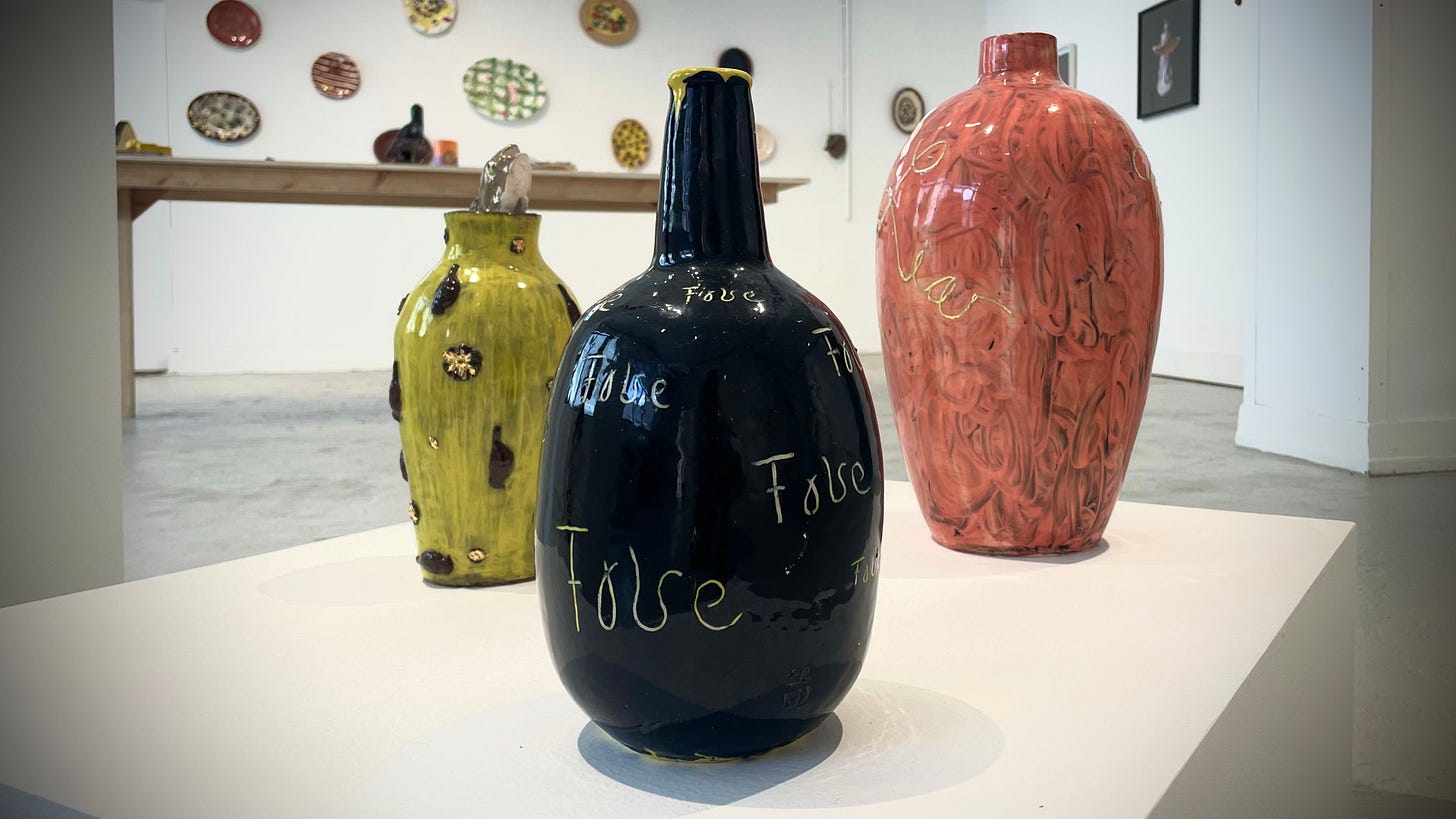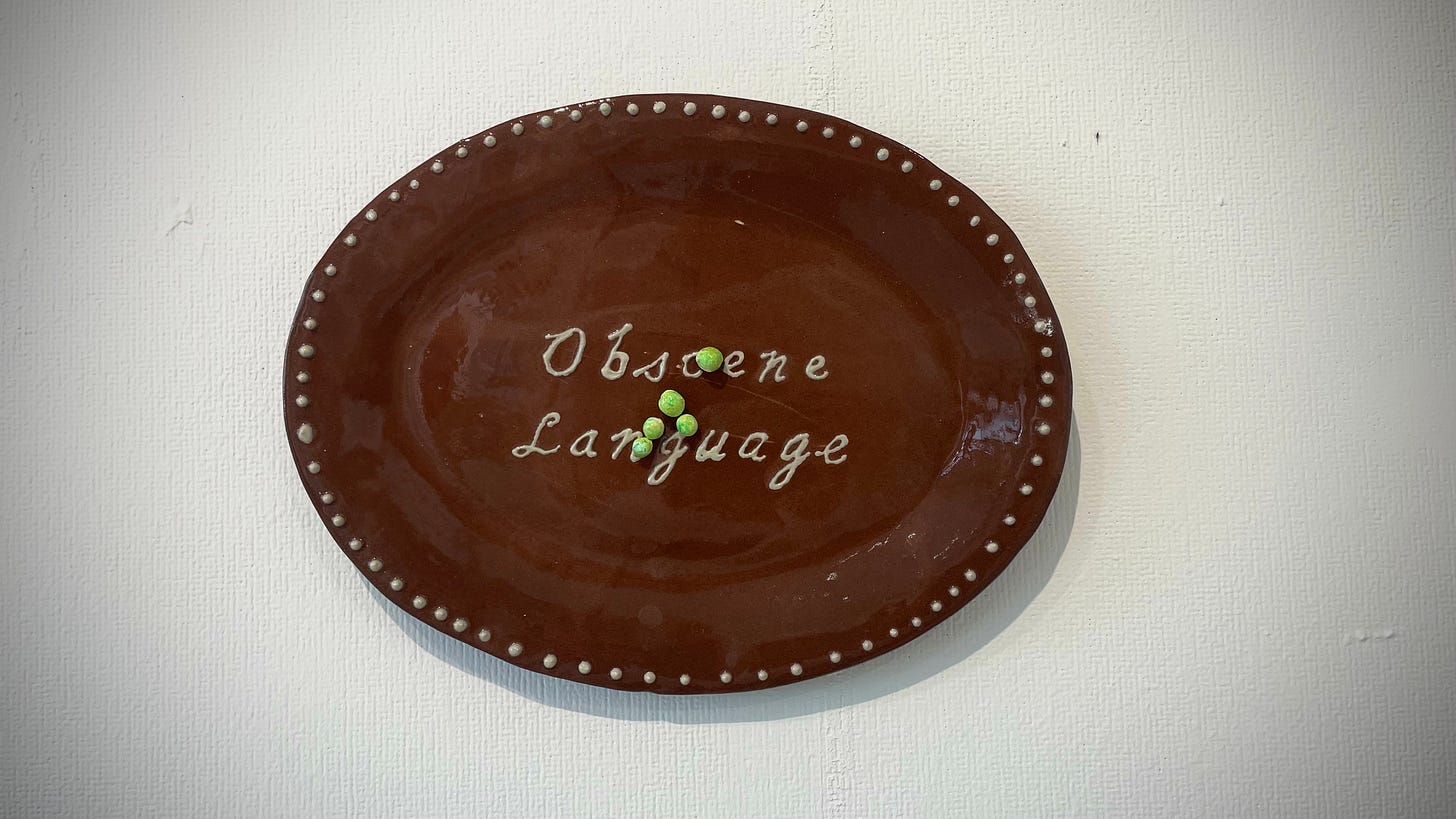Is that all there is, is that all there is.... sings Peggy Lee in a preternaturally child-like voice, the words winding around the ceramics and sculptures by Karen Densham on view at the Art Station in Saxmundham.
Is That All There Is?, a song inspired by Disillusionment, a short story by Thomas Mann, plays against a video of Densham pulling a roll-neck top down slowly over her face, and daubing lipstick around her mouth. The lyrics tell of a little girl who sees her house burning, watching everything go up in flames, And when it was over / I said to myself / Is that all there is to fire? Is that all there is?
Peggy Lee's voice might be playing on a record made of fired and glazed clay, a flat disc on which a ceramic fish wriggles, casting ripples (thus the title, Ripple Effect) which disappear into thin air. There is a lightness and levity to it, a sort of shrug - is that all there is? In the end all there is, is matter, which doesn’t matter.
The lyrics of the song get darker, more existential. A circus disappoints (I had the feeling that something was missing), a lover leaves (I thought I would die, but I didn’t), even the thought of dying means nothing (I’m not ready for that final disappointment).
It is dark so we might as well laugh, or make a joke out it: a ceramic fly on the wall, a golden carrot made from clay, a literally spiked drink. Loss of innocence and laughter in the dark, these are the moods of Densham’s imaginings.
The joke is often funny not because it makes sense, but precisely the opposite — a crazy thing said in sleep, meaningful only to a lover, a close friend. A bear with knickers on its head. A polar bear on a water bottle. Ha ha ha. A decorative plate that proclaims 'nothing'. A truncated, addorsed donkey, two heads and no tail - no tale? Tell me that one again... Eeyore, either-or, tragi-comedy or comi-tragedy? Oh stop, stop.
A deconstructed joke, then, like sandwiches made from clay (in Densham's realm anything can be made from ceramic, at once the most fragile and durable medium), or a laptop clammed shut over a string of pearls, a metaphor for the underwater world, or for the sudden shock of porn; next to it a ceramic box of black tissues — the dark web, or a sign of mourning?
It doesn't stop at jokes — it cannot, for ceramics are a good place to tell the truth. To start a revolution, even. Faience Parlante — speaking ceramics, the name for porcelain made during the French Revolution with patriotic themes: Faience Patriotique!
Densham remembers the objects made in the Imperial Porcelain factory in Russia after the October Revolution, the completely unlikely tradition of Soviet revolutionary porcelain. A means of slipping dialectics onto the tea tray, the perfect place to épater les bourgeois. Kasimir Malevich made suprematist teapots — Densham puts the cart before the house with her constructivist plates. Where is the revolution?
Somewhere here, never far away — but never stated, never explained, an idea left hanging — an image. Is that all there is, we might ask of the long tress of dark hair hanging from the wall, or the butterfly hair clips glazed gold, left absent-mindedly on a windowsill.
Either you know or you don't. Keep your keys in hand to protect yourself in case of attack. Don't wear your hair in a ponytail if you want to stay safe walking home at night. Ceramic golden keys are set in a ceramic spoon, a primitive ritual weapon, a sign of the double-bind of it all, of the ritual of victim-blaming, of victim-silencing.
You were warned.
Every warning is both a loss of innocence and a sly shifting of responsibility. Only an image can speak both sides of the story, the doublethink of being simultaneously 'true' and 'false'. The word is written on a pot so cleverly that it can be read both ways, and also, at a push, as 'fake'.
Elsewhere a black top hat is filled with ducks that are hares that are ducks, the ear-beak illusion. We can see it as one or the other but not both at the same time, the psychologists say — and yet we can, can't we? Or perhaps we are liars, or perhaps the word 'liar' is a face that cannot fib. The donkey looks both ways and we don't know where we are, grasping our house keys in our hand.
But Bad Dies so that is all okay.
Except it doesn't really, does it? It is just covered up. Obscene Language proclaims a creamware decorative plate. Not swear words, the really bad ones — but a description of something that is hard to bear, an abuse of power, a moment of painful humiliation, a history of rape, broadcast to the world.
Reporters glossed over the details revealed in the trial of the men guilty of the rape of Gisèle Pelicot, drugged and abused by her husband and his grim accomplices.
When the descriptions of their crimes were deemed not fit for human ears — or perhaps it was their sheer repetitive boredom — news editors inserted the words 'obscene language', just as beeps were once used to cover swear words.
Obscene language — words swept under the carpet, off stage. What is there left to put on the stage after such an event, after such knowledge?
Nothing, perhaps, and yet something still.
The inexplicable humour of five green peas.
Is that all there is? A lump of clay formed and coloured and fired and shown. A scouring pad, a pan cleaner, a jay cloth, hanging on a wall, each with a girl's name. It might not be feminist, more an affectionate evocation of domestic life. Will you please do the washing up.
The wallpaper and light switches and Capodimonte porcelain figurines, lords and ladies, shepherds and harlequins, the sort of thing we used to find in our grandmother's house.
Or three doves in row, their heads anointed with bronze, silver, gold — pecking order, of course. If that's all there is my friends.
After life and love and marriage, what remains? Especially when a bear is a more desirable thing to encounter in a forest at night than a grown man. At least the bear would simply eat your dead body.
If that's all there is my friend,
Then let's keep dancing,
Let's break out the booze and have a ball,
If that's all there is.
Poor Form, an exhibition of ceramics by Karen Densham, is on view at the Art Station, Saxmundham, Suffolk until the 29th June 2025.





